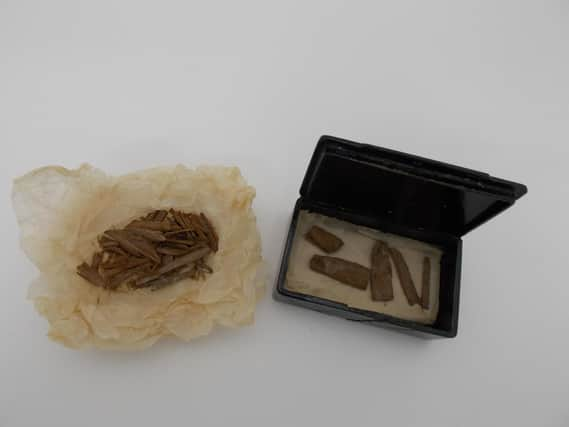'Lost' artefact from the Great Pyramid found in old cigar box in Aberdeen


The fragment of cedar was one of three items taken from inside the pyramid’s Queens chamber by 19th Century engineer Waynman Dixon with the other two objects – a ball and a hook – in the British Museum.
The five-inch piece of wood, which some believe may have been broken from a rule used during the construction of the pyramid, has long been missing and has now emerged ‘by chance’ in little pieces.
Advertisement
Hide AdAdvertisement
Hide AdThe item was found by curatorial assistant Abeer Eladany, who came across the cigar tin as she conducted a review of the University’s Asia collection.
READ MORE: Stunning new detail of Galloway Hoard revealed as 1,000 years of dirt are cleared from silver relic
Originally from Egypt, Ms Eladany was immediately intrigued given the object carried the former flag of Egypt and, after cross referencing with other records, she quickly realised what she was holding.
She said: “Once I looked into the numbers in our Egypt records, I instantly knew what it was, and that it had effectively been hidden in plain sight in the wrong collection.
“I’m an archaeologist and have worked on digs in Egypt but I never imagined it would be here in north-east Scotland that I’d find something so important to the heritage of my own country.
“The University’s collections are vast – running to hundreds of thousands of items – so looking for it has been like finding a needle in a haystack. I couldn’t believe it when I realised what was inside this innocuous-looking cigar tin.”
Radiocarbon dating has now placed the wood fragment to somewhere between 3341 and 3094BC – some 500 years before historical records date the Great Pyramid to the reign of the Pharaoh Khufu in 2580-2560BC.
This backs up a theory that the wood was present at the time the Great Pyramid was constructed and not left by later visitors.
Advertisement
Hide AdAdvertisement
Hide AdThe university was given the piece of wood in 1946 by the daughter of James Grant, from Methlick, a medic who travelled to Egypt in the mid-1860s to treat a cholera outbreak. There, he befriended Dixon and assisted him in the exploration of the Great Pyramid.
However, the item was never classified and despite an extensive search, could not be located.
Neil Curtis, Head of Museums and Special Collections at the University of Aberdeen, said: “Finding the missing Dixon Relic was a surprise but the carbon dating has also been quite a revelation.
“It is even older than we had imagined. This may be because the date relates to the age of the wood, maybe from the centre of a long-lived tree. Alternatively, it could be because of the rarity of trees in ancient Egypt, which meant that wood was scarce, treasured and recycled or cared for over many years.
“It will now be for scholars to debate its use and whether it was deliberately deposited, as happened later during the New Kingdom, when pharaohs tried to emphasise
continuity with the past by having antiquities buried with them.”